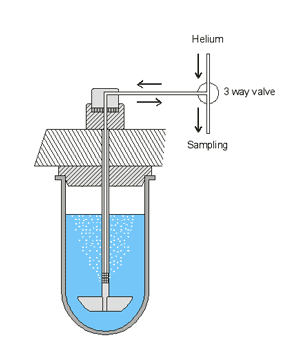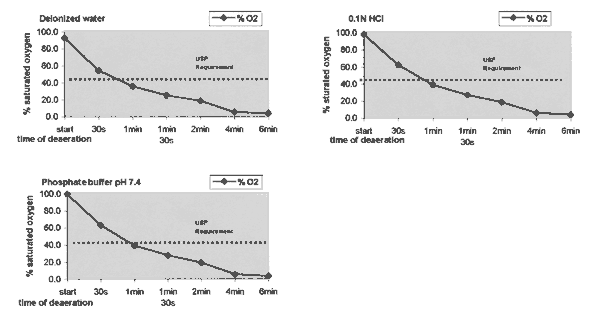
Product Profile:
In-Situ
Deaeration of Dissolution Media Through a Hollow ShaftTM System
Rolf Rolli,(1) Alexander Fiechter(1)
and Richard Hengst(2)
(1) SOTAX LTD., Basel, Switzerland
(2) SOTAX Corporation, Furlong, PA
email for correspondence:rolf.rolli@sotax.ch
Summary
Deaeration of dissolution media is required by the USP and therefore
a standard procedure in the quality control laboratory of the
pharmaceutical industry. Traditional methods using vacuum are
cumbersome, time consuming and bear the risk of reaeration during
dispensing of the media into the dissolution vessels.
A new in-situ method with direct deaeration in the dissolution
vessels just prior to the start of the dissolution test is described.
The experimental data show that the deaeration rate is much faster
than traditional methods and is more complete. This new deaeration
method works with a wide range of different media. The described
system is a very cost effective way to deaerate.
Introduction
It's well known and documented in the literature
that oxygen can influence the dissolution rate of solid dosage
forms [1]. Therefore, the health authorities have taken this into
consideration and require or recommend deaeration of the media.
The USP 23 states "Note-Dissolved gases can cause bubbles
to form, which may change the results of the test" [2]. As
a deaeration method the USP recommends: "Heat the medium,
while stirring gently, to about 45°C, immediately filter under
vacuum using a filter having a porosity of 0.45 mm or less, with
vigorous stirring under vacuum for about 5 minutes." In the
Ninth Supplement, USP-NF slightly alters the method [3]. This
method is cumbersome and time consuming. To overcome some of these
drawbacks, automated external media preparation stations are commercially
available. The USP also states that "Other validated deaeration
techniques for removal of dissolved gases may be used [2]. Several
authors have summarized different deaeration techniques that utilize
vacuum, heating, sonication, membranes and helium [4,5]. The helium
sparging method was considered expensive. According to our experience
this is due to lack of a good hardware design to dispense the
helium efficiently. The risk of reaeration during dispensing
of the media into the dissolution vessels is another problem.
Experiments in the SOTAX application lab show reaeration rates
from 20% to 60 % depending on the way the media is dispensed into
the dissolution vessels [6]. Other authors have studied the reaeration
and found up to a 275% increase in the oxygen level after dispensing
the media into the dissolution vessels [7].
We have developed an in-situ deaeration
technique applying the SOTAX Hollow ShaftTM stirrers.
The Hollow ShaftTM
stirrers are able to dispense
the helium very efficiently and deaeration of the dissolution
medium is executed very quickly in the test vessels. With this
system, the risk of reaeration during dispensing of the media
into the dissolution vessels is eliminated. The described apparatus
is also a very cost effective way to deaerate as it requires only
an additional 3-way valve, connected to a helium supply, besides
the standard SOTAX AT7smart automated dissolution tester equipped
with the Hollow ShaftTM system.
Experimental
Apparatus
SOTAX AT7smart equipped with the SOTAX Hollow ShaftTM
stirrers [8] connected to a 3-way valve and a helium source for
deaeration and fraction collector or UV spectrophotometer [Figure
1]. A WTW model OXI 320 Meter [9] with an oxygen sensor type
Cell Ox 325 was used to measure the % saturated oxygen content
in the dissolution media before and after the deaeration with
helium. The instrument was calibrated daily according to the manufacturer's
directions.
The in-situ deaeration is performed through the SOTAX Hollow ShaftTM system [10] which contains a sample opening and a 0.1 mm stainless steel pre-filter [Figure 2] which disperses helium bubbles finely and is also used for sampling.
Figure 1: Dissolution Apparatus equipped for in-situ deaeration

Figure 2: Hollow Shaft deaeration and Sampling System

Preparation of dissolution media
Deionized water, 0,1N HCl and phosphate buffer pH7.4 were used
in the evaluations.
Deaeration Techniques
Dissolution media is dispensed into each dissolution vessel and
then in-situ deaerated on-line with helium (1bar valve pressure)
through the Hollow ShaftTM.
Each medium was degassed at 37°C
and 100 rpm for up to 6 minutes.
After the short deaeration period
the dissolution test can start by switching a 3-way valve in the
lines of the Hollow ShaftTM system. The Hollow ShaftTM system
is then utilized for sampling on-line to a UV spectrophotometer
or off-line to a fraction collector.
Results
With each medium two tests were made and the oxygen level was
measured from start to 6 minutes. The mean and standard deviation
was calculated for each medium, deionized water, 0.1N HCI and
phosphate buffer pH7.4, (Tables 1-3, respectively).The mean %
saturated oxygen contents are plotted for each medium (Figures
1-3).
| Table 1: Deionized water | |||||||||
| % saturated oxygen content | |||||||||
| vessel # | start | 30 sec | 1min | 1.5min | 2min | 4min | 6min | ||
| 1 | 91.5 | 53.5 | 35 | 24 | 17.5 | 4 | 3 | ||
| Test 1 | 4 | 91 | 53.5 | 34.5 | 24 | 18 | 4.5 | 3 | |
| 7 | 91 | 54 | 34.5 | 24 | 18 | 4 | 3 | ||
| 1 | 93 | 54 | 35.5 | 24.5 | 18 | 5 | 3 | ||
| Test 2 | 4 | 92 | 53.5 | 36 | 25 | 17.5 | 5.5 | 3.5 | |
| 7 | 93 | 54 | 35.5 | 25.5 | 19 | 5 | 3.5 | ||
| mean | 91.9 | 53.8 | 35.2 | 24.5 | 18 | 4.7 | 3.2 | ||
| std. dev. | 0.917 | 0.274 | 0.606 | 0.632 | 0.548 | 0.606 | 0.258 |
| Table 2: 0.1N HCl | |||||||||
| % saturated oxygen content | |||||||||
| vessel # | start | 30sec | 1min | 1.5min | 2min | 4min | 6min | ||
| 1 | 97 | 61 | 38 | 26 | 18.5 | 5 | 3.5 | ||
| Test 1 | 4 | 98 | 62.5 | 38.5 | 26 | 17.5 | 5.5 | 3 | |
| 7 | 97 | 61.5 | 38.5 | 27 | 18 | 5 | 3.5 | ||
| 1 | 97.5 | 62 | 38.5 | 27.5 | 18 | 5 | 2.5 | ||
| Test 2 | 4 | 98.5 | 62 | 38 | 26.5 | 17.5 | 5.5 | 3.5 | |
| 7 | 98 | 61.5 | 38 | 26 | 18.5 | 5 | 3 | ||
| mean | 97.7 | 61.8 | 38.3 | 26.5 | 18 | 5.2 | 3.2 | ||
| std. dev. | 0.6055 | 0.5244 | 0.2739 | 0.6325 | 0.4472 | 0.2582 | 0.4082 |
| Table 3: Phosphate buffer pH 7.4 | |||||||||
| % saturated oxygen content | |||||||||
| vessel # | start | 30sec | 1min | 1.5min | 2min | 4min | 6min | ||
| 1 | 98 | 62 | 38 | 27 | 18.5 | 5 | 3.5 | ||
| Test 1 | 4 | 98.5 | 61.5 | 39 | 27.5 | 18 | 4.5 | 3 | |
| 7 | 99 | 63 | 39 | 27 | 19 | 5 | 3 | ||
| 1 | 99.5 | 63.5 | 38.5 | 27.5 | 18.5 | 5 | 3 | ||
| Test 2 | 4 | 99 | 63 | 38.5 | 27.5 | 18.5 | 5.5 | 3.5 | |
| 7 | 99 | 63 | 38 | 28 | 19 | 5 | 3 | ||
| mean | 98.8 | 62.7 | 38.5 | 27.4 | 18.6 | 5 | 3.2 | ||
| std. dev. | 0.5164 | 0.7528 | 0.4472 | 0.3764 | 0.3764 | 0.3162 | 0.2582 |
Figures 1-3. Top row Figures 1 and 2. Bottom row, Figure 3.

Conclusions
The data show that in-situ deaeration through the Hollow ShaftTM
is a fast method which can be applied with different dissolution
media. The consumption of helium is very low and takes only one
minute to fulfill USP requirements. In comparison it may require
up to one hour labor to do it manually. Also, the risk of reaeration
during dispensing is eliminated. The in-situ deaeration through
the Hollow ShaftTM can be utilized in a range of configurations
from on- or off-line systems and all the components are commercially
available.
References
[1] Hanson, W.A. , Handbook of Dissolution Testing, 2nd Edition,
Revised, Aster Publishing Corporation, Eugene, Oregon, 1991
[2] USP 24, January 1, 2000 page 1943
[3] Ninth Supplement, USP-NF , 4661
[4] Griffith, M.E., Curley, T.E., Martin, G.P., Consideration
in Choosing a Deaeration Technique for Dissolution Media. Dissolution
Technologies, Vol. 4, issue 1, February 1997, 16-17
[5] Qureshi, S.A., McGilveray, I.J., I. J. Drug Dev. Ind. Pharm.
21, (8) 905 (1995)
[6] Fiechter, A, Internal Communication, 15.7.(1999)
[7] Diebold, S.M., Dressman, J.B., De- and Reaeration of Aqueous
Media for Dissolution Testing. Pharm. Ind. 60, 354-359 (1998)
[8] SOTAX AG Basel, Switzerland
[9] WTW AG, Uznach, Switzerland
[10] SOTAX AG, Basel, Switzerland
Correspondence:
Rolf Rolli
Sotax Ltd Basel
CH-4123 Allschwil 1 Switzerland
Phone +41-61-487 54 54 Fax +41-61-482 13 31
email: rolf.rolli@sotax.ch